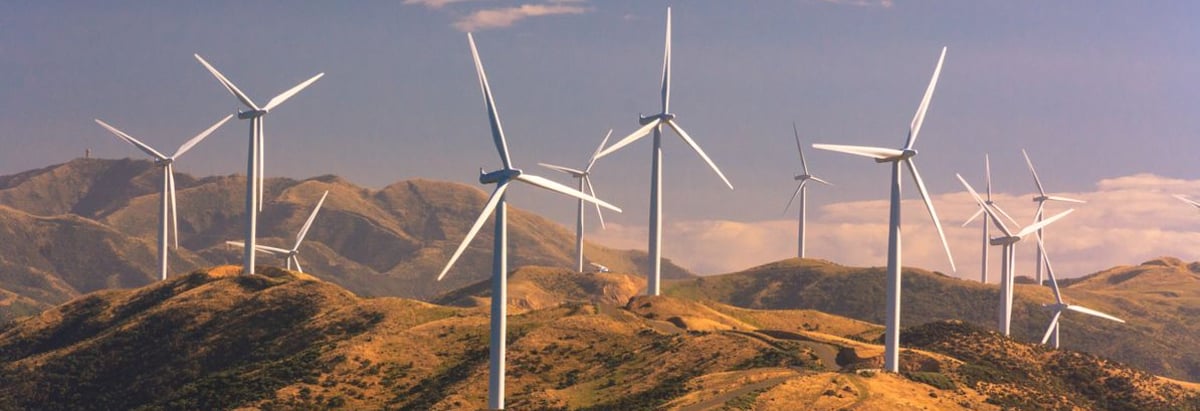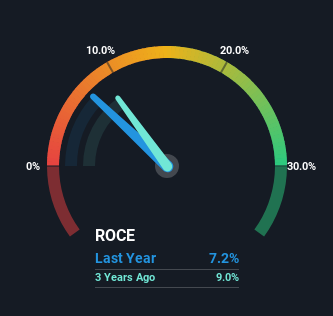- India
- /
- Renewable Energy
- /
- NSEI:ADANIGREEN
Adani Green Energy (NSE:ADANIGREEN) Might Have The Makings Of A Multi-Bagger

If we want to find a stock that could multiply over the long term, what are the underlying trends we should look for? In a perfect world, we'd like to see a company investing more capital into its business and ideally the returns earned from that capital are also increasing. Basically this means that a company has profitable initiatives that it can continue to reinvest in, which is a trait of a compounding machine. Speaking of which, we noticed some great changes in Adani Green Energy's (NSE:ADANIGREEN) returns on capital, so let's have a look.
Return On Capital Employed (ROCE): What Is It?
Just to clarify if you're unsure, ROCE is a metric for evaluating how much pre-tax income (in percentage terms) a company earns on the capital invested in its business. The formula for this calculation on Adani Green Energy is:
Return on Capital Employed = Earnings Before Interest and Tax (EBIT) ÷ (Total Assets - Current Liabilities)
0.072 = ₹42b ÷ (₹674b - ₹84b) (Based on the trailing twelve months to March 2023).
Therefore, Adani Green Energy has an ROCE of 7.2%. On its own, that's a low figure but it's around the 8.2% average generated by the Renewable Energy industry.
Check out our latest analysis for Adani Green Energy

In the above chart we have measured Adani Green Energy's prior ROCE against its prior performance, but the future is arguably more important. If you're interested, you can view the analysts predictions in our free report on analyst forecasts for the company.
How Are Returns Trending?
While in absolute terms it isn't a high ROCE, it's promising to see that it has been moving in the right direction. Over the last five years, returns on capital employed have risen substantially to 7.2%. The amount of capital employed has increased too, by 506%. So we're very much inspired by what we're seeing at Adani Green Energy thanks to its ability to profitably reinvest capital.
On a related note, the company's ratio of current liabilities to total assets has decreased to 13%, which basically reduces it's funding from the likes of short-term creditors or suppliers. This tells us that Adani Green Energy has grown its returns without a reliance on increasing their current liabilities, which we're very happy with.
The Bottom Line
A company that is growing its returns on capital and can consistently reinvest in itself is a highly sought after trait, and that's what Adani Green Energy has. And a remarkable 2,627% total return over the last five years tells us that investors are expecting more good things to come in the future. Therefore, we think it would be worth your time to check if these trends are going to continue.
If you want to continue researching Adani Green Energy, you might be interested to know about the 1 warning sign that our analysis has discovered.
While Adani Green Energy may not currently earn the highest returns, we've compiled a list of companies that currently earn more than 25% return on equity. Check out this free list here.
New: Manage All Your Stock Portfolios in One Place
We've created the ultimate portfolio companion for stock investors, and it's free.
• Connect an unlimited number of Portfolios and see your total in one currency
• Be alerted to new Warning Signs or Risks via email or mobile
• Track the Fair Value of your stocks
Have feedback on this article? Concerned about the content? Get in touch with us directly. Alternatively, email editorial-team (at) simplywallst.com.
This article by Simply Wall St is general in nature. We provide commentary based on historical data and analyst forecasts only using an unbiased methodology and our articles are not intended to be financial advice. It does not constitute a recommendation to buy or sell any stock, and does not take account of your objectives, or your financial situation. We aim to bring you long-term focused analysis driven by fundamental data. Note that our analysis may not factor in the latest price-sensitive company announcements or qualitative material. Simply Wall St has no position in any stocks mentioned.
About NSEI:ADANIGREEN
Adani Green Energy
Generates and supplies renewable energy to central and state government entities, and government backed corporations in India.
Exceptional growth potential very low.


